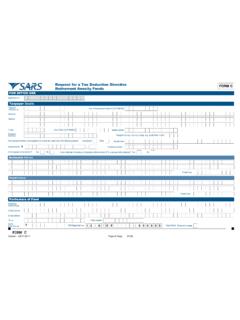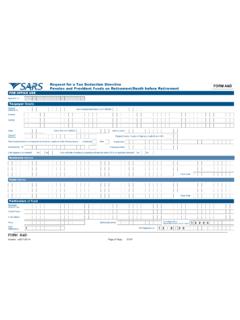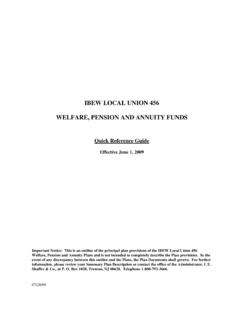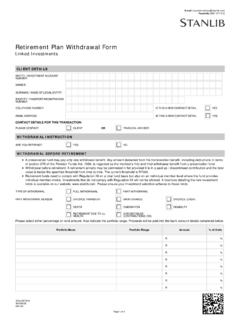Transcription of Charges in South African retirement funds - National Treasury
1 Technical Discussion Paper A for public comment Charges in South African retirement funds 11 July 2013 National Treasury 2 Contents Contents .. 2 1. Introduction .. 3 Executive Summary ..4 2. Background .. 15 The South African retirement landscape ..15 What are Charges and how are they measured? ..22 Next steps ..27 3. Non-commercial funds .. 28 Drivers of fund costs and Charges ..28 Charges in non-commercial retirement funds ..32 International comparison ..32 Draft policy options ..34 4. Commercial umbrella funds .. 36 Drivers of fund costs and Charges ..37 Charges in commercial umbrella funds ..40 International comparison ..42 Draft policy options ..42 5. retirement annuity and preservation funds .. 45 Drivers of fund costs and Charges ..45 Charges in retirement annuity and preservation funds ..52 International comparison.
2 53 Draft policy options ..55 6. Conclusion .. 56 Draft findings ..56 Draft policy options ..57 7. Comments .. 60 A: Alternative measures of Charges .. 61 B: International approaches to reducing retirement fund Charges .. 63 Restrictions on types and levels of Charges ..63 Other methods of reducing Charges ..65 The United Kingdom ..65 Australia ..67 C: Economics and finance of investment management .. 70 Active and passive investment management ..70 Portfolio and manager diversification ..73 Performance fees ..74 Smoothed bonus policies ..77 Investment platforms ..79 3 1. Introduction This paper is one of a series of technical discussion papers to promote household savings and reform the retirement industry. It follows on from the 2012 and 2013 Budget announcements by the Minister of Finance, and the overview papers Strengthening retirement Savings (14 May 2013) and 2013 retirement reform proposals for further consultation (27 February 2013).
3 Four other technical discussion papers on retirement reform were released over 2012, including: B. Enabling a better retirement income Reviews retirement income markets and measures to ensure that cost-effective, standardised and easily accessible products are available to the public. C. Preservation, portability and uniform access to retirement savings Gives consideration to phasing in preservation on job changes and divorce settlement orders, and harmonising annuitisation requirements. The aim is to strengthen retirement provisioning, long-term savings and fund governance. D. Incentivising non- retirement savings Discusses how short- to medium-term savings can be enhanced, and dependency on excessive credit reduced, through tax-preferred individual savings and investment accounts.
4 It also discusses the design of incentives to encourage savings in lower-income households. E. Simplifying the tax treatment of retirement savings Proposes harmonising tax treatment for contributions to retirement funds to simplify the tax regime around retirement fund contributions. All these papers are available on the National Treasury website This paper, Charges in South African retirement Funds1 presents an overview, based on the information available to National Treasury , of the current level of Charges during the accumulation phase ( before retirement ) in South African retirement funds , provides an international comparison, and examines the drivers of observed charge levels. Several possible draft options for reform are presented. It is not the goal of this paper to propose any particular approach.
5 Rather, it is intended to facilitate engagement with retirement funds , service providers and other stakeholders, as well as to promote public consultations on how the Charges of retirement funds can be reduced during the accumulation phase. The ultimate intention of the paper is to assist South Africans in getting the best possible value for the retirement savings they make. 1 In the overview paper, this paper A was initially referred to as retirement fund costs , but has been re-named to take account of the content. 4 Executive Summary The level of costs and Charges is a significant factor in determining the benefits a retirement fund member will receive in return for the contributions that were made to the fund . This paper presents an overview of the current level of Charges during the accumulation phase ( before retirement ) in South African retirement funds , provides an international comparison, and examines the drivers of observed charge levels.
6 Major determinants of the level of Charges are structural: the industry is fragmented, with approximately 3000 active retirement funds , most of which are small, membership in the system is voluntary, with only around half of formally-employed workers participating, and balances are low, partly because few members preserve their funds for retirement . The distinction between costs and Charges retirement funds of all types need to perform various functions. These may include distributing the fund to members and prospective members, providing financial advice to members, administering the fund and the benefits, providing risk benefits, and managing and administering investments. To perform each of these functions, the fund incurs expenses, which, if they occur on a fund level, are called costs for the purposes of this paper.
7 To cover these expenses, funds deduct monies from contributions or sell fund assets, reducing the value of members interest in the fund . These deductions, which occur at a member level, are called Charges for the purposes of this paper. Most funds recover all of their costs by levying Charges on members (although some employers may contribute towards the cost of running employer-related funds directly, or indirectly by performing services on behalf of the fund ). In practice, it is extremely uncommon for the Charges to be recovered from members in a way which exactly matches the incurred costs of a fund . Examples of retirement fund costs Typically, South African retirement funds perform several functions. Individual members must know about the fund , and must join it, and may receive financial advice before they do so.
8 funds must be administered, pay for risk benefits and manage investments. These functions are summarised for the different retirement funding channels in Box 1 below. Determinants of retirement fund costs The main factors determining the cost of retirement funds include: The size of the fund . Significant fixed costs of running a fund , and economies of scale in fund administration and investment management mean that funds with more members and greater funds incur costs which are recovered from members through Charges The main determinants of the costs of retirement funds 5 assets under management typically have lower costs per member or per unit of assets than smaller funds . Degree of preservation. Systems with a greater degree of preservation accumulate more assets per member, all else being equal, and are therefore cheaper per unit of assets invested.
9 The fact that rates of preservation in South Africa are low therefore implies that costs will be higher than they could otherwise be. Box 1: Summary of interaction between fund functions and retirement savings channels Distribution and financial advice Administration Risk benefits Investment management Stand-alone and non-commercial umbrella funds Automatic distribution through employers; financial advice not usually given Purchased in group market by trustees, usually under advice from consultants Purchased in group market by trustees, usually under advice from consultants Purchased in group market by trustees usually under advice from consultants; some funds may offer member choice Commercial umbrella funds Distribution to employers through brokers, who may provide financial advice to groups of employees; mandatory membership for employees. fund selected by employer or management committee of sub- fund Purchased in group market, usually separately for each participating employer; risk benefit design often customised Options selected by trustees; selection made by employer and/or trustees of sub- fund ; some sub- funds may offer member choice retirement annuity and preservation funds Agents and brokers distribute and may provide individual financial advice fund selected by individual member Risk benefits not usually part of these funds & may be purchased separately in individual market Options selected by trustees; individual member usually exercises choice Extent of compulsion.
10 Whether the fund or system is mandatory or voluntary. Generally employer, union, bargaining council and sectoral determination funds are mandatory once a fund has been set up. retirement annuity funds and commercial umbrella funds need to be marketed and sold to prospective clients, who may be individuals or employers, adding to their cost, and with implications for their design. Degree of subsidy. Whether some fund functions are centralised or subsidised. It is not uncommon for employers to subsidise some plan functions, and in some countries, but not in South Africa, a centralised clearing house performs many plan functions. Level and cost of risk benefits. The level and cost of risk benefits, which are particularly important in South Africa. funds with high numbers of lower-paid workers have much higher risk benefit costs than funds with higher-paid workers, reflecting higher probabilities of death and disability.

















